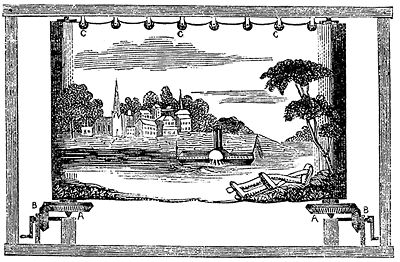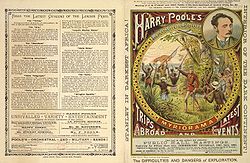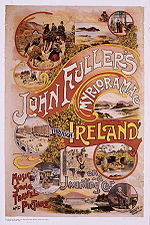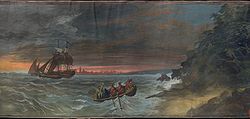
Moving panorama
Encyclopedia

Panoramic painting
Panoramic paintings are massive artworks that reveal a wide, all-encompassing view of a particular subject, often a landscape, military battle, or historical event. They became especially popular in the 19th Century in Europe and the United States, inciting opposition from writers of Romantic poetry...
, but proved to be more durable than its fixed and immense cousin. The word “panorama” is derived from the Greek words “to see” and “all.” Robert Barker invented the first panorama to describe his impressive paintings of Edinburgh in 1791. However, these paintings were not true panorama
Panorama
A panorama is any wide-angle view or representation of a physical space, whether in painting, drawing, photography, film/video, or a three-dimensional model....
s, but rather contiguous views of passing scenery, as if seen from a boat or a train window. Installed on immense spools, they were scrolled past the audience behind a cut-out drop-scene or proscenium
Proscenium
A proscenium theatre is a theatre space whose primary feature is a large frame or arch , which is located at or near the front of the stage...
which hid the mechanism from public view. Unlike panoramic painting, the moving panorama almost always had a narrator, styled as its "Delineator" or "Professor", who described the scenes as they passed and added to the drama of the events depicted. One of the most successful of these delineators was John Banvard
John Banvard
John Banvard was a U.S. panorama and portrait painter known for his panoramic views of the Mississippi River Valley.John Banvard was born in New York and was educated in high school...
, whose panorama of a trip up (and down) the Mississippi River
Mississippi River
The Mississippi River is the largest river system in North America. Flowing entirely in the United States, this river rises in western Minnesota and meanders slowly southwards for to the Mississippi River Delta at the Gulf of Mexico. With its many tributaries, the Mississippi's watershed drains...
had such a successful world tour that the profits enabled him to build an immense mansion, lampooned as "Banvard's Folly", built on Long Island
Long Island
Long Island is an island located in the southeast part of the U.S. state of New York, just east of Manhattan. Stretching northeast into the Atlantic Ocean, Long Island contains four counties, two of which are boroughs of New York City , and two of which are mainly suburban...
in imitation of Windsor Castle
Windsor Castle
Windsor Castle is a medieval castle and royal residence in Windsor in the English county of Berkshire, notable for its long association with the British royal family and its architecture. The original castle was built after the Norman invasion by William the Conqueror. Since the time of Henry I it...
. In Britain, showmen such as the durable Moses Gompertz toured the provinces with a variety of such panoramas from the 1850s until well into the 1880s. In the mid-nineteenth century, the moving panorama was among the most popular forms of entertainment in the world, with hundreds of panoramas constantly on tour in the United Kingdom
United Kingdom
The United Kingdom of Great Britain and Northern IrelandIn the United Kingdom and Dependencies, other languages have been officially recognised as legitimate autochthonous languages under the European Charter for Regional or Minority Languages...
, the United States
United States
The United States of America is a federal constitutional republic comprising fifty states and a federal district...
, and many European countries.
Moving panoramas were often seen in Melodramatic plays. It became a new visual element to theatre and helped incorporate a more realistic quality. Not only was it a special effect on stage, but it also served as an ancestor and platform to early cinema.
Popular subjects
Moving panoramas (or sometimes moving dioramaDiorama
The word diorama can either refer to a nineteenth century mobile theatre device, or, in modern usage, a three-dimensional full-size or miniature model, sometimes enclosed in a glass showcase for a museum...
s) often recreated grand ceremonies. In Philadelphia in 1811 nearly 1300 feet (396.2 m) of painted cloth were unwound to display the federal procession of 1788, and George IV's coronation in London was treated as a "Grand Historical Peristrephic Panorama" by the Marshall brothers. Exotic landscapes and travel were popular themes, particularly trips to India
India
India , officially the Republic of India , is a country in South Asia. It is the seventh-largest country by geographical area, the second-most populous country with over 1.2 billion people, and the most populous democracy in the world...
, New Zealand
New Zealand
New Zealand is an island country in the south-western Pacific Ocean comprising two main landmasses and numerous smaller islands. The country is situated some east of Australia across the Tasman Sea, and roughly south of the Pacific island nations of New Caledonia, Fiji, and Tonga...
, and the Arctic regions. Banvard
John Banvard
John Banvard was a U.S. panorama and portrait painter known for his panoramic views of the Mississippi River Valley.John Banvard was born in New York and was educated in high school...
's enormous Mississippi River
Mississippi River
The Mississippi River is the largest river system in North America. Flowing entirely in the United States, this river rises in western Minnesota and meanders slowly southwards for to the Mississippi River Delta at the Gulf of Mexico. With its many tributaries, the Mississippi's watershed drains...
panorama was shown on both sides of the Atlantic and a moving panorama of "Romantic and Picturesque Scenery in the Environs of Hobart
Hobart
Hobart is the state capital and most populous city of the Australian island state of Tasmania. Founded in 1804 as a penal colony,Hobart is Australia's second oldest capital city after Sydney. In 2009, the city had a greater area population of approximately 212,019. A resident of Hobart is known as...
Town" taken to London in 1839 allowed people in England to get an impression of Australia
Australia
Australia , officially the Commonwealth of Australia, is a country in the Southern Hemisphere comprising the mainland of the Australian continent, the island of Tasmania, and numerous smaller islands in the Indian and Pacific Oceans. It is the world's sixth-largest country by total area...
. A narrator explained the scenes passing in front of the audience and music played. In the United States
United States
The United States of America is a federal constitutional republic comprising fifty states and a federal district...
, moving panoramas were popular throughout the 1850s and 1860s, with multiple touring shows operated by proprietors such as Edwin Beale, T.K. Treadwell, and George K. Goodwin; among the more popular subjects were the Arctic regions, major cities such as New York
New York City
New York is the most populous city in the United States and the center of the New York Metropolitan Area, one of the most populous metropolitan areas in the world. New York exerts a significant impact upon global commerce, finance, media, art, fashion, research, technology, education, and...
, and Niagara Falls
Niagara Falls
The Niagara Falls, located on the Niagara River draining Lake Erie into Lake Ontario, is the collective name for the Horseshoe Falls and the adjacent American Falls along with the comparatively small Bridal Veil Falls, which combined form the highest flow rate of any waterfalls in the world and has...
.
Peter Grain
Peter Grain
Peter Grain was a French-American artist who achieved success in the United States. Known for his panoramas, landscapes, portraits, dioramas, portrait miniatures, and theatrical designs, he was also an architect and the author of at least one stage play...
's Panorama of the Hudson and James Rivers - Scenes in Virginia, painted in oil and watercolor, was exhibited at the San Francisco Hall in San Francisco in March 1853, concluding a tour of cities across the United States. The work covered 9,400 feet of canvas.
Poole's Myriorama

United Kingdom
The United Kingdom of Great Britain and Northern IrelandIn the United Kingdom and Dependencies, other languages have been officially recognised as legitimate autochthonous languages under the European Charter for Regional or Minority Languages...
traveling panorama shows had been operated by several firms, among them the Marshall brothers of Glasgow
Glasgow
Glasgow is the largest city in Scotland and third most populous in the United Kingdom. The city is situated on the River Clyde in the country's west central lowlands...
and J.B. Laidlaw. However, it was not until the 1850s that a nearly year-round programme of such shows was offered by Moses Gompertz, who with his assistants the Poole brothers traveled the length and breadth of Britain. Gompertz continued in this line of work through the mid-1880s, when his business was taken over by the Pooles. To distinguish theirs from rival shows, they started to use the name Myriorama, and by 1900 they had seven separate shows touring for 40 weeks of the year. They added elaborate effects to the scrolling paint-and-cloth panoramas: cut-out figures moving across the scene, accompanied by music, lighting and sound effects. The narrator, often one of the Poole brothers in evening dress
Evening dress
Evening dress may refer to:* White tie, the most formal civilian dress code in Western fashion* Black tie, a semi-formal dress code for evening events and social functions in Western fashion...
, would describe and interpret. "Poole's Myriorama" was well-known and is even mentioned in James Joyce
James Joyce
James Augustine Aloysius Joyce was an Irish novelist and poet, considered to be one of the most influential writers in the modernist avant-garde of the early 20th century...
's Ulysses
Ulysses (novel)
Ulysses is a novel by the Irish author James Joyce. It was first serialised in parts in the American journal The Little Review from March 1918 to December 1920, and then published in its entirety by Sylvia Beach on 2 February 1922, in Paris. One of the most important works of Modernist literature,...
.
Stories of travel and adventure, often military adventure, were popular: the action was conveyed by hidden stagehands moving shaped flats
Flats (theatre)
Flats, short for Scenery Flats, are flat pieces of theatrical scenery which are painted and positioned on stage so as to give the appearance of buildings or other background. They are also called backdrops or backcloths....
across a fixed backdrop. One naval battle had them manoeuvring ships accompanied by gunshot noises, puffs of smoke and Rule Britannia with waves on a rippling cloth at the front of the stage. Some shows, with variety
Variety show
A variety show, also known as variety arts or variety entertainment, is an entertainment made up of a variety of acts, especially musical performances and sketch comedy, and normally introduced by a compère or host. Other types of acts include magic, animal and circus acts, acrobatics, juggling...
acts as well as myriorama
Myriorama
Myriorama originally meant a set of illustrated cards which 19th century children could arrange and re-arrange, forming different pictures. Later in the century the name was also applied to shows using a sequence of impressive visual effects to entertain and inform an audience...
displays, employed dozens of people.
Some of the first films seen in the UK were presented in late 19th century myriorama shows. Although cinema
Film
A film, also called a movie or motion picture, is a series of still or moving images. It is produced by recording photographic images with cameras, or by creating images using animation techniques or visual effects...
eventually replaced the myriorama, this kind of entertainment stayed popular until the late 1920s, and was considered a Christmas-time treat. In December 1912 the Pooles first presented their Loss of the Titanic in "eight tableaux", starting with "a splendid marine effect" of the ship gliding across the scene. A descendant of theirs, Hudson John Powell, gathered together the family story in Poole's Myriorama!: a stmaneuveringory of travelling panorama showmen (2002). The Guardian
The Guardian
The Guardian, formerly known as The Manchester Guardian , is a British national daily newspaper in the Berliner format...
has called their myrioramas part of the "popular visual culture of the 19th century".
The last of the Poole family who were in the Myriorma business was Joseph Reginald Poole (1882 - 1950).
His father Charles William Poole had taken over all the familie's entertainment concerns.
In 1937, he published the book
One Hundred Years of Showmanship
This is available in digitised version from the Bill Douglas Collection, held by Exeter University
Fuller's Myriorama

Magic lantern
The magic lantern or Laterna Magica is an early type of image projector developed in the 17th century.-Operation:The magic lantern has a concave mirror in front of a light source that gathers light and projects it through a slide with an image scanned onto it. The light rays cross an aperture , and...
images rather than paintings wound on rollers. Their shows offered a changing display of pictures accompanied by commentary and music.
Surviving moving panoramas

United States
The United States of America is a federal constitutional republic comprising fifty states and a federal district...
is the Grand Moving Panorama of Pilgrim's Progress, which was found in storage at the York Institute, now the Saco Museum, in Saco, Maine
Saco, Maine
Saco is a city in York County, Maine, United States. The population was 18,482 at the 2010 census. It is home to Ferry Beach State Park, Funtown Splashtown USA, Thornton Academy, as well as General Dynamics Armament Systems , a subsidiary of the defense contractor General Dynamics...
by its former curator Tom Hardiman. It was found to incorporate designs by many of the leading painters of its day, including Jasper Francis Cropsey
Jasper Francis Cropsey
Jasper Francis Cropsey was an important American landscape artist of the Hudson River School.-Biography:Cropsey was born on his father Jacob Rezeau Cropsey's farm in Rossville on Staten Island, New York, the oldest of eight children. As a young boy, Cropsey had recurring periods of poor health....
, Frederic Edwin Church
Frederic Edwin Church
Frederic Edwin Church was an American landscape painter born in Hartford, Connecticut. He was a central figure in the Hudson River School of American landscape painters...
, and Henry Courtney Selous
Henry Courtney Selous
Henry Courtney Selous , was an English painter, illustrator and lithographer. He was the son of Gideon "George" Slous , a Flemish portrait and miniature painter, and a pupil of John Martin who was an important and influential English painter of the 19th century...
(Selous was the in-house painter for the original Barker panorama in London for many years). Another significant panorama, Russell and Purrington's "Whaling Voyage 'Round the World," is in the collection of the New Bedford Whaling Museum
New Bedford Whaling Museum
The New Bedford Whaling Museum is located in New Bedford, Massachusetts, USA. The museum, through its collections and exhibitions, tells the story of the international whaling industry and the history more generally of the "Old Dartmouth" area, the Southcoast of Massachusetts...
, although it was recently taken off display following renovations. C.C.A. Christiansen's "Mormon Panorama" survives at Brigham Young University
Brigham Young University
Brigham Young University is a private university located in Provo, Utah. It is owned and operated by The Church of Jesus Christ of Latter-day Saints , and is the United States' largest religious university and third-largest private university.Approximately 98% of the university's 34,000 students...
's Museum of Art, where it has been the subject of several recent shows and lectures.
Another moving panorama was donated to the Anne S. K. Brown Military Collection at Brown University Library in 2005. Painted in Nottingham, England around 1860 by John James Story (d. 1900), it depicts the life and career of the great Italian patriot, Giuseppe Garibaldi (1807–1882). The panorama stands about 4½ feet high and approximately 140 feet (42.7 m) long, painted on both sides in watercolor. Numerous battles and other dramatic events in his life are depicted in 42 scenes, and the original narration written in ink survives.
See also
- Wayang beber
- Myriorama (cards)
- Panoramic paintingPanoramic paintingPanoramic paintings are massive artworks that reveal a wide, all-encompassing view of a particular subject, often a landscape, military battle, or historical event. They became especially popular in the 19th Century in Europe and the United States, inciting opposition from writers of Romantic poetry...
- EmakimonoEmakimono, often simply called , is a horizontal, illustrated narrative form created during the 11th to 16th centuries in Japan. Emakimono combines both text and pictures, and is drawn, painted, or stamped on a handscroll...
- Route panoramaRoute panoramaRoute panorama is a continuous 2D image that includes all the scenes visible from a route, as it first appeared in Zheng and Tsuji′s work of panoramic views in 1990. Different from a local panorama at a static viewpoint, a digital route panorama is constructed from partial views at consecutive...
- DioramaDioramaThe word diorama can either refer to a nineteenth century mobile theatre device, or, in modern usage, a three-dimensional full-size or miniature model, sometimes enclosed in a glass showcase for a museum...
- MelodramaMelodramaThe term melodrama refers to a dramatic work that exaggerates plot and characters in order to appeal to the emotions. It may also refer to the genre which includes such works, or to language, behavior, or events which resemble them...
- Nineteenth-century theatre
- RomanticismRomanticismRomanticism was an artistic, literary and intellectual movement that originated in the second half of the 18th century in Europe, and gained strength in reaction to the Industrial Revolution...
- Nineteenth Century
- Scenic paintingScenic paintingTheatrical scenic painting includes wide-ranging disciplines, encompassing virtually the entire scope of painting and craft techniques. An experienced scenic painter will have skills in landscape painting, figurative painting, trompe l'oeil, and faux finishing, be versatile in different media such...
- Theatrical sceneryTheatrical sceneryTheatrical scenery is that which is used as a setting for a theatrical production. Scenery may be just about anything, from a single chair to an elaborately re-created street, no matter how large or how small, whether or not the item was custom-made or is, in fact, the genuine item, appropriated...
External links
- The Moving Panorama, a Forgotten Mass Medium of the 19th Century
- Play the Panorama infinite moving panorama project.
- The Dyer Library and Saco Museum
- The History of the Discovery of Cinematography Burns, Paul.
- Arctic Panoramas of Dr. Elisha Kent Kane
- Moving Panoramas at the Bill Douglas Centre at the University of Exeter.
- Garibaldi & the Risorgimento (Brown University)
- Programme for a myriorama show
- The Poole Brothers
- Meridian Magazine's article on the Mormon Panorama
- Digital Route Panorama

